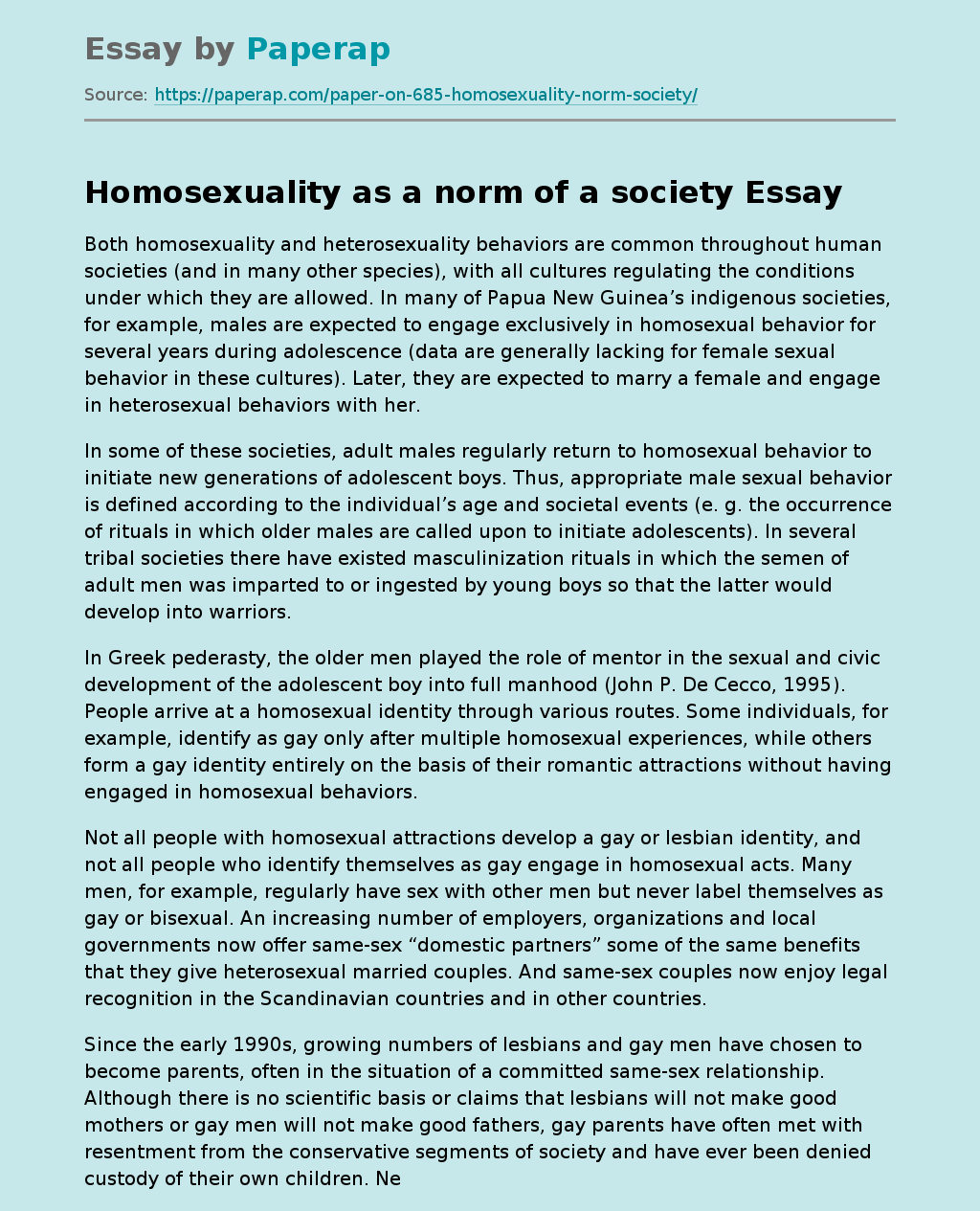Homosexuality as a Norm of a Society
Both homosexuality and heterosexuality behaviors are common throughout human societies (and in many other species), with all cultures regulating the conditions under which they are allowed. In many of Papua New Guinea’s indigenous societies, for example, males are expected to engage exclusively in homosexual behavior for several years during adolescence (data are generally lacking for female sexual behavior in these cultures). Later, they are expected to marry a female and engage in heterosexual behaviors with her.
In some of these societies, adult males regularly return to homosexual behavior to initiate new generations of adolescent boys.
Thus, appropriate male sexual behavior is defined according to the individual’s age and societal events (e. g. the occurrence of rituals in which older males are called upon to initiate adolescents). In several tribal societies there have existed masculinization rituals in which the semen of adult men was imparted to or ingested by young boys so that the latter would develop into warriors.
In Greek pederasty, the older men played the role of mentor in the sexual and civic development of the adolescent boy into full manhood (John P.
De Cecco, 1995). People arrive at a homosexual identity through various routes. Some individuals, for example, identify as gay only after multiple homosexual experiences, while others form a gay identity entirely on the basis of their romantic attractions without having engaged in homosexual behaviors.
Not all people with homosexual attractions develop a gay or lesbian identity, and not all people who identify themselves as gay engage in homosexual acts.
Many men, for example, regularly have sex with other men but never label themselves as gay or bisexual. An increasing number of employers, organizations and local governments now offer same-sex “domestic partners” some of the same benefits that they give heterosexual married couples. And same-sex couples now enjoy legal recognition in the Scandinavian countries and in other countries.
Since the early 1990s, growing numbers of lesbians and gay men have chosen to become parents, often in the situation of a committed same-sex relationship. Although there is no scientific basis or claims that lesbians will not make good mothers or gay men will not make good fathers, gay parents have often met with resentment from the conservative segments of society and have ever been denied custody of their own children. Nevertheless, lesbian and gay families are increasingly common.
Yet another phenomenon encompassed in “homosexuality” in the United States (and many other societies) is minority group membership. In the twentieth century, society increasingly came to regard gay people as a minority group, and individuals sharing a gay or lesbian identity developed visible communities similar to ethnic, religious, and cultural minorities. Empirical research indicates that gay men and lesbians in the Unites States manifest greater psychological and social adjustment to the extent that they identify with and feel part of a community (Raymond J Corsini, 2001).
Prison sexuality The structure of the prison environment makes prison sexuality a unique focus for research. When inmates enter prison society, they lose many of their basic human rights. One of this is privacy. Privacy is compromised within the prison system because the prison is a “total institution. ” Prison is an unnatural environment because it deprives the individual of fundamental rights, possessions, experiences, and relationships. Sex is prohibited because of this condition; prisons inherently create conflict because they are dominating institutions.
The most recent research on the prison sexual hierarchy came from a study of three male prisons in Oklahoma conducted by Hensley in 1998-1999. Inmates discussed that there were three “traditional” sexual roles found in male prisons (wolves, fags, punks). There are also subcategories within both the wolf and fag roles. Inmates labeled the two subcategories of wolves as the “aggressive wolf” and the nonaggressive wolf. ” The aggressive wolf was depicted as someone of African American descent who was both physically and verbally “tough.
” These inmates entered prison with a heterosexual orientation and maintained their masculinity by sexually assaulting younger, weaker inmates (punks). Raping a punk had more to do with power than sex. Non-aggressive wolves (or “teddy bears”), on the other hand, typically did not sexually assault their sex partners. But somehow they sought sexual relationships with other inmates (“fish” or “closet gays”) who were willing to engage in consensual homosexual activity while in prison.
They tended to be Caucasian men who entered prison with a heterosexual identity and maintained their masculine role by participating in active role during sex. However, when asked about their current sexual orientation, over half of the nonaggressive wolves answered that they were now bisexual. Therefore, many of these inmates – because of the lack of heterosexual sex in prison – had changed their self – impression regarding their sexual orientation. The two subcategories of fags, on the other hand, included fish and the closet gays.
Fish were typically African American males who took on a feminine role and appearance. They wore make-up, displayed female mannerisms, and took on female nicknames. Fish entered into prison life homosexual and maintained their homosexual identity, by assuming the passive role during sexual activity. Closet gays were typically Caucasian males who entered prison with a “hidden” homosexual identity. They have the ability to take on both the active and passive role during sexual activity. They did, however, try to maintain masculine appearances and mannerisms (Hensley, 2002).
Homosexuality as a Norm of a Society. (2017, May 13). Retrieved from https://paperap.com/paper-on-685-homosexuality-norm-society/

